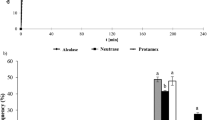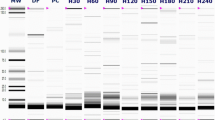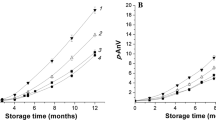Abstract
This study evaluated the effect of in vitro digestion of flaxseed products on Folin-Ciocalteu reagent reducing substances (FCRRS), its antioxidant capacity and prevention of oxidative DNA damage in human monocyte cell line U937. Flaxseed protein isolate was obtained from defatted flaxseed meal and the protein hydrolysate with high antioxidant capacity was obtained from hydrolysis of the protein isolate with Alcalase in a two factor central composite rotatable design (pH 8.5 and enzyme: substrate 1:90, w/w). The FCRRS content and antioxidant capacity measured by FRAP and ORAC in aqueous and 70 % methanol extracts were the highest in protein hydrolysate, followed by protein isolate, while the defatted meal showed the lowest values. After in vitro gastrointestinal digestion, the FCRRS content of protein isolate and hydrolysate reached similar values, however the hydrolysate had the highest antioxidant capacity, measured by FRAP while the isolate had the highest ORAC values. The defatted meal showed the lowest capacity in all assays (p < 0.05). The hydrolysate did not protect against DNA damage induced by H2O2 in U937 cells under the conditions of the present study. The results suggest that flaxseed protein isolate and hydrolysate are potential functional food ingredients with antioxidant capacity.


Similar content being viewed by others
Abbreviations
- CCRD:
-
Central composite rotatable design
- DFM:
-
Defatted flaxseed flour
- FCRRS:
-
Folin-Ciocalteu reagent reducing substances
- FPI:
-
Flaxseed protein isolate
- FPH:
-
Flaxseed protein hydrolysate
- FRAP:
-
Ferric reducing antioxidant power
- GI:
-
Gastrointestinal
- ORAC:
-
Oxygen radical absorbance capacity
- PDFM:
-
Partially defatted brown flaxseed meal
- ROS:
-
Reactive oxygen species
References
Shahidi F (2000) Antioxidants in food and food antioxidants. Nahrung 44:158–163
Samaranayaka AGP, Li-Chan ECY (2011) Food-derived peptidic antioxidants: A review of their production, assessment, and potential applications. J Funct Foods 3:229–254
Bouayed J, Hoffmann L, Bohn T (2011) Total phenolics, flavonoids, anthocyanins and antioxidant activity following simulated gastro-intestinal digestion and dialysis of apple varieties: Bioaccessibility and potential uptake. Food Chem 128:14–21
Jang I-C, Park J-H, Park E et al (2008) Antioxidative and antigenotoxic activity of extracts from cosmos (Cosmos bipinnatus) flowers. Plant Foods Hum Nutr 63:205–210
Rabetafika HN, Van Remoortel V, Danthine S et al (2011) Flaxseed proteins: Food uses and health benefits. Int J Food Sci Technol 46:221–228
Marambe P, Shand P, Wanasundara J (2008) An in-vitro investigation of selected biological activities of hydrolysed flaxseed (Linum usitatissimum L.) proteins. J Am Oil Chem Soc 85:1155–1164
Udenigwe CC, Lu Y-L, Han C-H et al (2009) Flaxseed protein-derived peptide fractions: Antioxidant properties and inhibition of lipopolysaccharide-induced nitric oxide production in murine macrophages. Food Chem 116:277–284
Adler-Nissen J (1986) Enzymic hydrolysis of food proteins, 1st edn. Elsevier Applied Science Publishers, New York, pp 110–131
AOAC (1995) Official methods of analysis, 18th edn. Association of Official Analytical Chemists, Arlington
Bligh EG, Dyer WJ (1959) A rapid method of total lipid extraction and purification. Can J Biochem Physiol 37:911–917
Wanasundara P, Shahidi F (2003) Flaxseed proteins: Potential food applications and process-induced changes. In: Thompson LU, Cunnane SC (eds), Flaxseed in human nutrition, 2nd edn. AOCS Press, Champaign, pp 387–403
Medina MB (2011) Simple and rapid method for the analysis of phenolic compounds in beverages and grains. J Agric Food Chem 59:1565–1571
Laemmli UK (1970) Cleavage of structural proteins during the assembly of the head bacteriophage T4. Nature 27:680–685
Schäger H, Jagow G (1987) Tricine-sodium dodecyl sulfate-polyacrylamide gel electrophoresis for the separation of proteins in the range from 1 to 100 kDa. Anal Biochem 166:368–379
Thaipong K, Boonprakob U, Crosby K et al (2006) Comparison of ABTS, DPPH, FRAP, and ORAC assays for estimating antioxidant activity from guava fruit extracts. J Food Compos Anal 19:669–675
Dávalos A, Gómez-Cordovés C, Bartolomé B (2004) Extending applicability of the oxygen radical absorbance capacity (ORAC-fluorescein) assay. J Agric Food Chem 52:48–54
Nielsen PM, Petersen D, Dambmann C (2001) Improved method for determining food protein degree of hydrolysis. Food Chem Toxicol 66:642–646
Martos G, Contreras P, Molina E et al (2010) Egg white ovalbumin digestion mimicking physiological conditions. J Agric Food Chem 58:5640–5648
Krause J-P, Schultz M, Dudek S (2002) Effect of extraction conditions on composition, surface activity and rheological properties of protein isolates from flaxseed (Linum usitativissimum L). J Sci Food Agric 82:970–976
Tang C-H, Peng J, Zhen D-W et al (2009) Physicochemical and antioxidant properties of buckwheat (Fagopyrum esculentum Moench) protein hydrolysates. Food Chem 115:672–678
Siger A, Nogala-Kalucka M, Lampart-Szczapa E (2008) The content and antioxidant activity of phenolic compounds in cold-pressed plant oils. J Food Lipids 15:137–149
Gamel TH, Linssen JP, Mesallam AS et al (2006) Seed treatments affect functional and antinutritional properties of amaranth flours. J Sci Food Agric 86:1095–1102
Ho CHL, Cacace JE, Mazza G (2007) Extraction of lignans, proteins and carbohydrates from flaxseed meal with pressurized low polarity water. LWT-Food Sci Technol 40:1637–1647
Kosińska A, Penkacik K, Wiczkowski W et al (2011) Presence of caffeic acid in flaxseed lignan macromolecule. Plant Foods Hum Nutr 66:270–274
Arcan I, Yemenicioglu A (2010) Effects of controlled pepsin hydrolysis on antioxidant potential and fractional changes of chickpea proteins. Food Res Int 43:140–147
Siracusa L, Kulisic-Bilusic T, Politeo O et al (2011) Phenolic composition and antioxidant activity of aqueous infusions from Capparis spinosa L. and Crithmum maritimum L. before and after submission to a two-step in vitro digestion model. J Agric Food Chem 59:12453–12459
Saura-Calixto F, Serrano J, Goñi I (2007) Intake and bioaccessibility of total polyphenols in a whole diet. Food Chem 101:492–501
Orsini Delgado MC, Tironi VA, Añón MC (2011) Antioxidant activity of amaranth protein or their hydrolysates under simulated gastrointestinal digestion. LWT-Food Sci Technol 44:1752–1760
Ou B, Huang D, Hampsch-Woodill M et al (2002) Analysis of antioxidant activities of common vegetables employing oxygen radical absorbance capacity (ORAC) and ferric reducing antioxidant power (FRAP) assays: a comparative study. J Agric Food Chem 50:3122–3128
Tagliazucchi D, Verzelloni E, Bertolini D et al (2010) In vitro bio-accessibility and antioxidant activity of grape polyphenols. Food Chem 120:599–606
Babbs CF (1990) Free radicals and the etiology of colon cancer. Free Radical Bio Med 8:191–200
Barbouti A, Doulias P-T, Zhu B-Z et al (2001) Intracellular iron, but not copper, plays a critical role in hydrogen peroxide-induced DNA damage. Free Radical Bio Med 31:490–498
Eeckhaut E, Struijs K, Possemiers S et al (2008) Metabolism of the lignan macromolecule into enterolignans in the gastrointestinal lumen as determined in the simulator of the human intestinal microbial ecosystem. J Agric Food Chem 56:4806–4812
Acknowledgments
The authors thank FAPESP (2009/51580-1 and 2010/52680-7) for the financial support and CAPES for the scholarship granted to F.G.D. Silva.
Author information
Authors and Affiliations
Corresponding author
Rights and permissions
About this article
Cite this article
Silva, F.G.D., O’Callagahan, Y., O’Brien, N.M. et al. Antioxidant Capacity of Flaxseed Products: The Effect of In vitro Digestion. Plant Foods Hum Nutr 68, 24–30 (2013). https://doi.org/10.1007/s11130-012-0329-6
Published:
Issue Date:
DOI: https://doi.org/10.1007/s11130-012-0329-6




